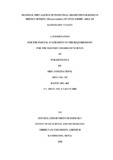Please use this identifier to cite or link to this item:
https://elibrary.tucl.edu.np/handle/123456789/3546Full metadata record
| DC Field | Value | Language |
|---|---|---|
| dc.contributor.author | Nepal, Sangita | - |
| dc.date.accessioned | 2021-07-27T06:02:14Z | - |
| dc.date.available | 2021-07-27T06:02:14Z | - |
| dc.date.issued | 2010 | - |
| dc.identifier.uri | http://elibrary.tucl.edu.np/handle/123456789/3546 | - |
| dc.description.abstract | Altogether 300 faecal samples of Rhesus monkey were collected within two seasons, summer and winter season from Swoymabhu area. Equal numbers of samples were collected in both seasons. The current study was carried out in order to observe the seasonal prevalence of intestinal helminth parasites of Rhesus monkey. Sedimentation and floatation technique were used to detect the helminith parasites. Out of 300 samples, 255 (85%) were found to be positive and rest 45 (15%) were found to be negative. The present study revealed the prevalence of nematodes (75%), cestodes (10%) and trematodes (15%). In Nematodes genera, Strongyloides sp., Trichostrongylus sp. and Toxocara sp., were found to be in higher number. In Tremotodes genera, Schistosoma sp. was found in higher number. Similarly, in Cestodes genera, Dipylidium sp. was found in higher number.In nematodes genera, Bunostomum sp., cestodes genera, Dipylidium sp., in trematodes genera, Schistosoma sp., were reported for the first time in Nepal in Rhesus monkey. Among the total 255 positive samples, 101 (39.61%) were found to have single infection and rest 154 (60.39%) were found to have multiple infection. The general prevalence for three different genera is as follows: Nemotodes – Strongyloides sp. (27.06%), Trichostrongylus sp. (11.37%) Dictyocaulus sp. (7.45%), Haemonchus sp. (4.31%), Ostertagia sp. (5.88%), Trichuris sp. (9.80%), Capillaria sp. (6.27%), Toxocara sp. (12.94%), Chabertia sp. (8.63%), Ascaris sp. (7.45%), Oesophagostomum sp. (10.59%), Ancylostoma sp. (2.75%), Bunostomum sp. (1.96%), Oxyuris sp. (3.14%) and Cooperia sp. (4.31%).Trematodes: Dicrocoelium sp. (9.80%), Schistosoma sp. (18.04%) and Fasciola sp. (9.80%). Cestodes: Taenia sp. (9.80%) and Dipylidium sp. (9.80%). The average prevalence of helminth parasite was found to be 85% during both the seasons. The prevalence in summer (86.67%) is higher than the prevalence in winter season (83.33%). All the genus and species of intestinal parasites are reported here for the second time from Rhesus monkey (Macaca mulatta) from Nepal where Schistosoma, Fasciola, Dipylidium and Bunostomum are reported for the first time in Nepal. The difference in prevalence of helminth parasites during both seasons were found statistically significant (χ2=16.73, P<0.05, d.f.=2). Key words: Helminth, Trematodes, Cestodes Nematodes, Parasite, Prevalence, Sedimentation, Flotation. | en_US |
| dc.language.iso | en_US | en_US |
| dc.publisher | Central Department of Zoology | en_US |
| dc.subject | Helminth | en_US |
| dc.subject | Trematodes | en_US |
| dc.subject | Flotation | en_US |
| dc.title | Seasonal Prevalence of Intestinal Helminth Parasites in Rhesus Monkey (Macaca Mulatta) of Swoyambhu Area of Kathmandu Valley | en_US |
| dc.type | Thesis | en_US |
| local.institute.title | Central Department of Zoology | en_US |
| local.academic.level | Masters | en_US |
| Appears in Collections: | Zoology | |
Files in This Item:
| File | Description | Size | Format | |
|---|---|---|---|---|
| Cover.pdf | 41.74 kB | Adobe PDF |  View/Open | |
| Chapter.pdf | 687.28 kB | Adobe PDF |  View/Open |
Items in DSpace are protected by copyright, with all rights reserved, unless otherwise indicated.
